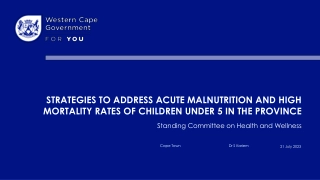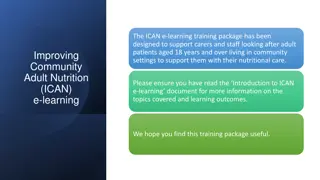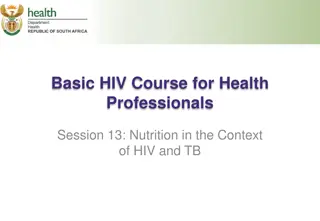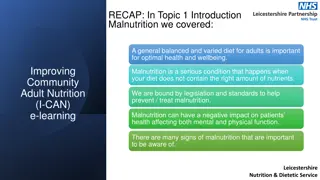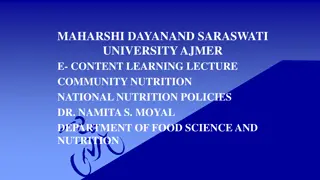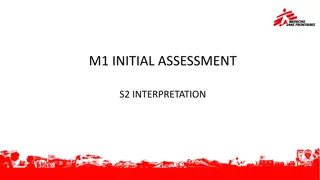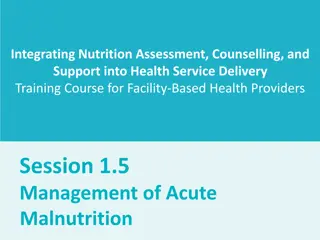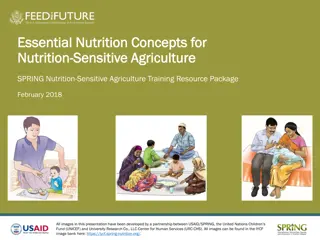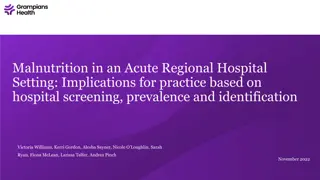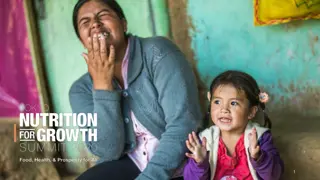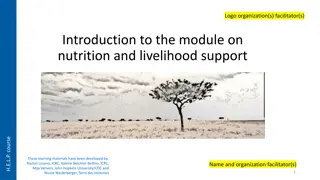Global Nutrition Report 2019: Progress Against Malnutrition Targets
The Global Nutrition Report tracks progress and actions against global nutrition targets, aiming for a world free from malnutrition. Despite efforts, no country is on track to meet targets for adult obesity and anemia in women. The report highlights the coexistence of wasting, stunting, and overweight in children under five, but indicates a global decline in stunting and wasting. Promising reductions in stunting have been seen in countries like Paraguay and Thailand. Overall, global progress is being made but challenges remain to combat malnutrition effectively.
Download Presentation

Please find below an Image/Link to download the presentation.
The content on the website is provided AS IS for your information and personal use only. It may not be sold, licensed, or shared on other websites without obtaining consent from the author. Download presentation by click this link. If you encounter any issues during the download, it is possible that the publisher has removed the file from their server.
E N D
Presentation Transcript
@GNReport @globalnutritionreport The state of global nutrition Setting the scene Dr Mariachiara Di Cesare, Senior Lecturer, Middlesex University & Honorary Research Fellow, Imperial College London
Why do we need the Global Nutrition Report?
The Global Nutrition Report The Global Nutrition Report (GNR) was conceived of, following the first Nutrition for Growth (N4G) summit in 2013, to track progress against global nutrition targets along with the financing, commitments and actions designed to reach them. Vision A world free from malnutrition in all its forms. Mission The Global Nutrition Report drives greater action to end malnutrition in all its forms.
The global picture Source: Global Nutrition Report, 2019. Country Nutrition Profiles: Global. Not a single country in the world is on course to meet global nutrition targets for adult obesity or anaemia in women of reproductive age.
Coexistence of wasting, stunting and overweight in under-fives 3.5% of children are stunted and wasted 1.7% of children are stunted and overweight Source: Global Nutrition Report, 2019. Country Nutrition Profiles: Global. Notes: Percentage of children under-five years of age who experience different and overlapping forms of malnutrition. Based on population weighted means of 111 countries.
Globally, stunting and wasting in under-fives is declining Wasting by gender Stunting by gender Source: Global Nutrition Report, 2019. Country Nutrition Profiles: Global.
Stunting has decreased globally to 21.9% COUNTRY LEVEL PROGRESS: TARGET 1: 40% reduction in the number of children under 5 who are stunted Paraguay 48% reduction in stunting among under-fives since 2012, from 74,100* to 38,300* in 2016. GLOBAL PROGRESS: Thailand 39%* reduction in stunting among under-fives since 2012, from 657,000* in 2012 to 398,000* in 2016. Source: Global Nutrition Report, 2019. Country Nutrition Profiles: Global. *Numbers and percentages with an asterisk were updated on 21.11.2019 in line with updated UN population data.
Exclusive breastfeeding has increased to 41.2% COUNTRY LEVEL PROGRESS: TARGET 5: Increase the rate of exclusive breastfeeding in the first 6 months to at least 50% Burkina Faso Rates of exclusive breastfeeding rose from 6% to over 50% between 2006 and 2014. GLOBAL PROGRESS: India India achieved the exclusive breastfeeding target in 2015, rising from 46% in 2005 to 55% in2015%. Source: Global Nutrition Report, 2019. Country Nutrition Profiles: Global.
Progress to reduce malnutrition is inconsistent Source: Global Nutrition Report, 2019. Country Nutrition Profiles: Global.
Anaemia, overweight and obesity in adults continues to rise Source: Global Nutrition Report, 2019. Country Nutrition Profiles: Global.
How can we speed up progress?
Evidence-based policies and programmes are key to speeding up progress More countries have mandatory fortification 86 countries require at least one type of cereal grain to be fortified. Governments are acting to improve diets 73 countries impose taxes on sugar-sweetened beverages. Multi-sector action in cities is growing Obesity among children of all age groups declined from 21% in 2012 to 18.5% in 2015 in Amsterdam, where the Healthy Weight Programme has been ongoing since 2012. Multi-level, community- based interventions show rapid impact In Ethiopia, minimum dietary diversity increased from 5.2% in 2015 to 24.9% in2017 among children that participated in the Alive & Thrive Initiative.
Nutrition for Growth commitment tracking 7 out of 10 countries are on course to meet programme commitments. 7 out of 11 countries are on course to meet impact commitments. 14 out of 14 countries have met or are on course to meet policy commitments. Yemen reached its commitment to finalise a National SUN Plan, establish realistic targets and publish its nutrition spending. Malawi has met its commitment to develop a Nutrition Act and to scale up the coverage of community-based nutrition services.
Financial commitments 5 out of 11 countries have met or are on course to meet their financial commitments. Malawi has made progress towards its commitment to increase the proportion of annual government expenditure allocated to nutrition. Yemen is on course to establish new budget lines for nutrition programming in the ministries of Health, Water and Environment, as well as Food and Agriculture. Senegal has reached its commitment to increase funding for nutrition each year, allocating 6 billion in local currency in 2018.
Thank you @GNReport @globalnutritionreport Development Initiatives Ltd North Quay House Quay side Temple Back Bristol BS1 6FL globalnutritionreport.org 18



